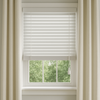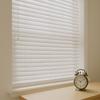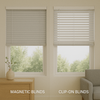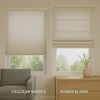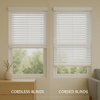How Long Do Window Blinds Typically Last, and How Can You Extend Their Life?
- by Mariam Labadze
 Quick Answer
Quick Answer
Quality window treatments typically last 7-15 years depending on material type, usage frequency, environmental conditions, and maintenance practices. Wooden options often exceed 15 years with proper care, whilst fabric varieties average 7-10 years before fading or wear necessitates replacement. PVC and aluminum versions provide 10-12 years of reliable service, particularly in moisture-prone environments. Extending lifespan requires regular cleaning, gentle operation, protecting from excessive moisture and direct sunlight, periodic hardware maintenance, and addressing minor issues promptly before they escalate. Initial investment in quality products from reputable suppliers delivers superior longevity compared to budget alternatives that may require replacement within 3-5 years.
[toc]
Expected Lifespan by Material Type
-
Wooden blinds – 15-20 years with proper maintenance; premium hardwoods can last 25+ years
-
Faux wood alternatives – 12-18 years; excellent moisture resistance extends bathroom and kitchen longevity
-
Fabric roller and Roman styles – 7-10 years; sunlight exposure and fabric quality significantly impact lifespan
-
Aluminum venetian – 10-15 years; durable metal resists damage though mechanisms may require maintenance
-
PVC and vinyl – 10-12 years; particularly long-lasting in high-humidity environments like bathrooms
-
Cellular or honeycomb designs – 8-12 years; delicate structure requires careful handling
-
Vertical options – 8-12 years; individual slat replacement extends overall system longevity
Understanding What Affects Longevity
Multiple factors influence how long window treatments remain functional and attractive. Understanding these variables helps set realistic expectations whilst informing decisions about material selection, placement, and maintenance approaches.
Material Quality – Premium materials inherently last longer than budget alternatives. Solid hardwoods outlast engineered wood products, heavy-duty fabrics resist fading better than lightweight materials, and quality mechanisms operate smoothly for years whilst cheap hardware fails prematurely. Initial investment in quality products pays dividends through extended lifespans reducing replacement frequency.
Usage Frequency – Treatments operated multiple times daily experience more wear than those adjusted occasionally. Kitchen windows opened for ventilation throughout the day, or bedroom treatments raised and lowered twice daily, accumulate more stress on mechanisms than guest room windows adjusted weekly. High-traffic areas justify particularly durable selections.
Environmental Exposure – Direct sunlight causes fabric fading, warps wooden slats, and degrades synthetic materials over time. South-facing windows receive intense UV exposure accelerating deterioration, whilst north-facing treatments age more slowly. Moisture in bathrooms and kitchens challenges materials differently than dry bedroom environments.
Maintenance Practices – Regular cleaning prevents dust buildup that abrades surfaces and mechanisms. Gentle operation avoids unnecessary stress on components. Periodic hardware checks identify loosening screws or worn parts before failures occur. Consistent care dramatically extends functional lifespans beyond neglected equivalents.
Installation Quality – Properly installed treatments operate smoothly without binding, uneven wear, or mechanical stress. Poor installation creates operational difficulties that accelerate component wear and premature failure. Professional installation or careful DIY attention ensures optimal longevity from quality products.
Climate Conditions – UK weather presents particular challenges—damp winters encourage mold on unsuitable materials, whilst increasingly warm summers fade fabrics and expand wooden components. Regional variations across the UK affect longevity, with coastal properties facing salt exposure and Scottish homes enduring harsher winters.
The Benefits of Quality Window Treatments
Before exploring specific maintenance practices, understanding the comprehensive advantages that quality window treatments provide contextualizes why extending their lifespan through proper care delivers substantial value.
Long-Term Cost Effectiveness – Quality treatments lasting 12-15 years prove more economical than budget options requiring replacement every 4-5 years. When amortized across their lifespans, premium products often cost less per year whilst delivering superior performance and aesthetics throughout their service lives.
Consistent Aesthetic Appeal – Quality materials maintain appearance over time without premature fading, warping, or visible wear. Your windows continue looking fresh and intentional years after installation, supporting overall interior design without the gradual deterioration that budget alternatives exhibit.
Enhanced Property Value – Well-maintained, quality window treatments signal properly cared-for homes to potential buyers. They contribute to positive first impressions and demonstrate attention to detail that serious buyers recognize and value during property viewings.
Energy Efficiency Benefits – Quality treatments with proper fit and construction provide consistent insulation throughout their lifespans. Budget alternatives may develop gaps, warping, or material degradation that compromises thermal performance, negating energy-saving benefits that initially justified their installation.
Operational Reliability – Premium mechanisms operate smoothly for years without jamming, sticking, or failing. This daily convenience proves valuable throughout the product's life, avoiding frustration and inconvenience that unreliable budget alternatives create.
Reduced Waste and Environmental Impact – Longer-lasting products reduce landfill waste and resource consumption associated with manufacturing replacements. Choosing durable treatments and maintaining them properly aligns with sustainable living principles whilst saving money.
Essential Maintenance Practices
Regular Cleaning Routines – Dust accumulation abrads surfaces, embeds in mechanisms, and creates unsightly appearances that make treatments seem older than actual age. Establish weekly or fortnightly cleaning routines using appropriate methods for your specific material type.
For aluminum and PVC options, gentle vacuuming with brush attachments removes loose dust efficiently. Follow with damp microfiber cloths wiping individual slats, removing accumulated grime without excessive moisture that might damage mechanisms or leave streaks.
Fabric treatments require more careful attention. Vacuum gently using upholstery attachments, working from top to bottom to avoid redistributing dust. Spot-clean marks immediately using manufacturer-recommended solutions, testing on inconspicuous areas first ensuring no discoloration or damage occurs.
Wooden varieties benefit from specialized wood cleaning products that clean whilst conditioning the finish. Avoid excessive moisture that can cause warping or finish damage. Occasional application of appropriate wood care products maintains luster and prevents drying or cracking.
Gentle Operation Techniques – Handle operating mechanisms carefully, avoiding forceful pulls or jerky movements that stress components. Raise and lower treatments smoothly at moderate speeds rather than yanking cords or rapidly deploying spring mechanisms. This gentle approach reduces wear on pulleys, springs, and cord systems.
When adjusting slat angles on venetian styles, rotate wands or tilt mechanisms slowly and deliberately. Forcing stuck slats risks breaking individual pieces or damaging the entire tilting mechanism. If resistance occurs, investigate the cause rather than applying force.
For Roman or roller varieties, guide fabric evenly when raising or lowering to prevent bunching or uneven gathering that creates stress points. Ensure fabric tracks smoothly without catching on frame edges or hardware that might cause tears or permanent creasing.
Moisture Management – Bathrooms and kitchens present moisture challenges that accelerate deterioration when not properly managed. After steamy showers, open windows or activate ventilation fans reducing humidity exposure. Wipe moisture droplets from treatments promptly preventing water damage or mold development.
For moisture-prone areas, selecting inherently resistant materials—PVC, faux wood, or specially treated fabrics—provides additional protection. Even these durable options benefit from active moisture management extending their already impressive bathroom and kitchen longevity.
In particularly damp UK climates or properties with condensation issues, periodically check treatments for early signs of mold or mildew. Address problems immediately with appropriate cleaning solutions before damage becomes extensive or permanent.
Hardware Maintenance – Quarterly inspections of mounting brackets, chains, cords, and mechanisms identify developing issues before catastrophic failures occur. Tighten loose screws preventing brackets from pulling away from walls or frames. Lubricate moving parts with appropriate products ensuring smooth, quiet operation.
Examine cords and chains for fraying, wear, or damage. Replace compromised components promptly—waiting until complete failure occurs often results in secondary damage to other parts. Most suppliers provide replacement parts at reasonable costs, making preventive maintenance economical.
Check tilt mechanisms, wands, and operating rods for looseness or damage. Tighten connections and replace worn components maintaining reliable operation. These minor interventions performed regularly prevent major failures requiring complete replacement.
Addressing Common Issues Promptly
Fabric Fading – Sunlight exposure inevitably fades fabrics over time, though UV-protective treatments and quality materials resist this process longer. Rotate fabric treatments occasionally if possible, distributing sun exposure more evenly. Consider UV-filtering window films providing additional fabric protection in particularly sunny locations.
When fading becomes noticeable, assess whether it bothers you aesthetically or simply represents natural aging. Minor fading might remain acceptable for years, whilst significant color loss may justify replacement even if mechanisms remain functional.
Warped or Bent Slats – Individual damaged slats on venetian or vertical styles needn't necessitate complete replacement. Many systems allow individual slat replacement at modest cost, extending overall lifespan significantly. Contact suppliers about replacement parts rather than assuming entire treatments require replacement.
For minor warping on wooden slats, sometimes gentle straightening proves possible. Moisture application followed by careful bending while wet, then drying flat under weight, occasionally corrects problems. However, this requires care and understanding of wood properties to avoid creating worse damage.
Mechanism Failures – Broken chains, worn pulleys, or failed spring systems often receive repair rather than requiring complete replacement. Professional repair services handle mechanism rehabilitation, and some handy homeowners successfully perform repairs using replacement parts and online tutorials.
Evaluate repair costs against replacement prices. If repair approaches 50-60% of new treatment costs, replacement might prove more sensible, particularly if other components show wear suggesting additional failures loom. However, repairing relatively new treatments with isolated problems maximizes value from initial investments.
Operational Difficulties – Treatments that stick, bind, or operate inconsistently signal problems requiring attention. Often these issues stem from accumulated dust in tracks, loose brackets allowing misalignment, or minor hardware adjustments. Systematic troubleshooting frequently identifies simple solutions avoiding expensive repairs or premature replacement.
When to Repair vs. Replace
Repair Makes Sense When:
-
Treatments are relatively recent (under 5 years) with isolated problems
-
Repair costs remain under 40-50% of replacement prices
-
Materials and finish remain attractive without fading or significant wear
-
Mechanisms otherwise function properly with only specific component failures
-
Replacement parts remain available from manufacturers
Replacement Proves Wiser When:
-
Multiple components show wear or failure suggesting systemic issues
-
Fabric exhibits significant fading, staining, or damage throughout
-
Treatments approach or exceed expected lifespans for their material type
-
Repair costs approach replacement prices offering minimal savings
-
Aesthetic appeal has diminished making rooms feel dated or tired
-
Energy efficiency has degraded through warping, gaps, or material deterioration
Maximizing Your Investment
Choose Appropriate Materials – Select materials suited to specific room conditions. PVC or faux wood for bathrooms, fade-resistant fabrics for sunny rooms, and premium materials for showcase spaces receiving less challenging exposure. This thoughtful matching extends lifespan through environmental compatibility.
Professional Installation – Proper installation ensures optimal operation and lifespan. Brackets mounted securely, treatments hanging level, and mechanisms adjusted correctly all contribute to longevity. The £30-£60 per window installation cost proves economical when treatments last years longer through proper mounting.
Immediate Problem Resolution – Address minor issues promptly before escalation. Loose screws, slight operational difficulties, or small marks all worsen when ignored. Quick interventions prevent minor problems becoming major failures requiring extensive repairs or premature replacement.
Seasonal Adjustments – Consider seasonal treatment of wooden varieties applying conditioning products before dry winter heating or humid summer months. This preventive care maintains material integrity through challenging seasonal transitions common in UK climates.
Documentation and Warranty – Retain purchase documentation, warranty information, and care instructions. Understanding warranty coverage and proper maintenance requirements ensures you don't inadvertently void protection through inappropriate cleaning or handling. Register products when offered, enabling manufacturer contact for parts or advice.
Investment in Quality Pays Long-Term
Budget considerations naturally influence purchasing decisions, but focusing solely on initial costs overlooks total ownership expenses. A £50 treatment requiring replacement after 4 years costs £12.50 annually, whilst a £100 equivalent lasting 12 years costs just £8.33 per year whilst delivering superior performance throughout.
Quality treatments from reputable suppliers include better materials, superior construction, reliable mechanisms, and comprehensive warranties backing manufacturer confidence in product longevity. These factors justify premium pricing through extended, trouble-free service.
At 1 Click Blinds, quality products designed for UK homes combine durability with style, offering window treatments that enhance your spaces for years with proper care. Understanding expected lifespans, implementing appropriate maintenance routines, and addressing issues promptly ensures maximum value from your investment whilst maintaining beautiful, functional windows throughout your treatments' extended service lives.

